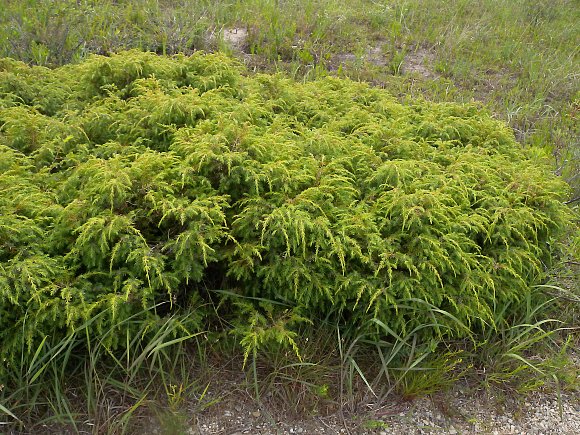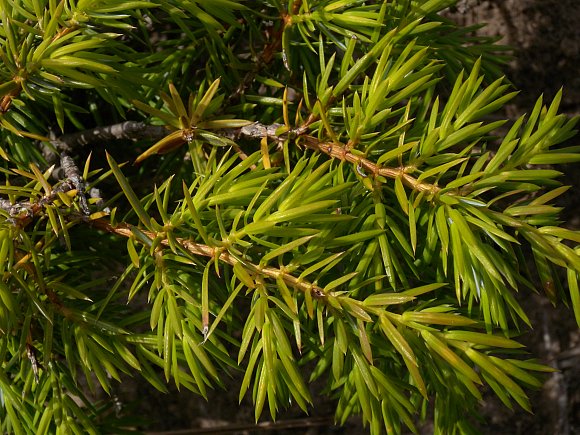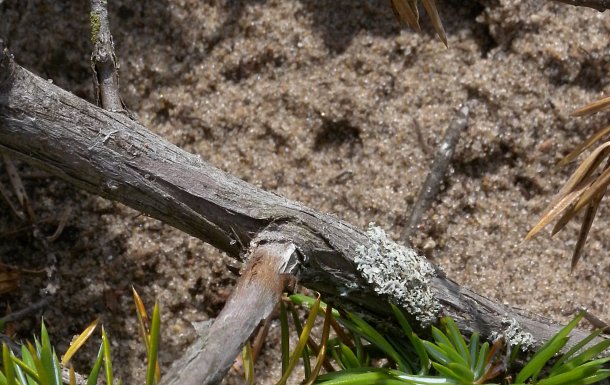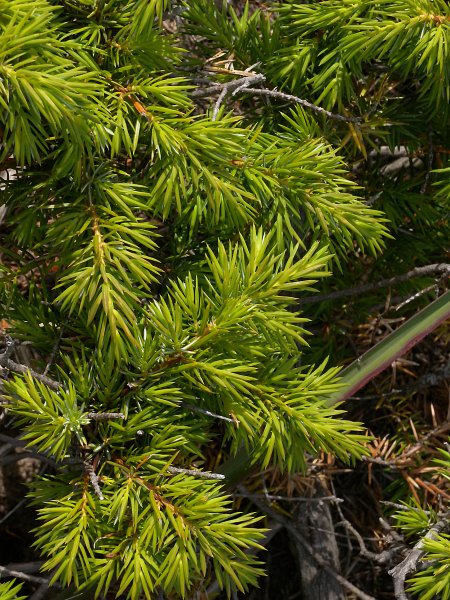
Canadian Juniper is usually dioecious (rarely monoecious), where male (staminate) flowers and female (pistillate) flowers occur on separate shrubs. These flowers are arranged into male and female inflorescences that are called 'strobili.' The male strobili are yellow to yellowish brown, ovoid in shape, and about 6 mm. (¼") in length; each male strobilus has several whorls of stamens. The axillary female strobili are green and about 2 mm. long; each female strobilus consists of a pistil that is surrounded by several persistent scales. The blooming period occurs during mid- to late spring, lasting about 1-2 weeks. The flowers are cross-pollinated by the wind. Afterwards, fertile female flowers are replaced by berry-like seed cones that take 2-3 years to mature. Both immature (green) seed cones and mature (blue) seed cones can occur on the same female shrub. Mature seed cones are 6-8 mm. across, more or less globoid in shape, and glaucous blue; the interior of each seed cone is fleshy-waxy, containing 2-3 seeds. Both the berry-like seed cones and foliage of this shrub have a pine-like scent. The woody root system is shallow and spreading. When lower branches and twigs become submerged in soil, they can form new roots, causing this shrub to spread clonally. During the winter, the leaves become brownish green.

Cultivation: The preference is full sun, dry-mesic conditions, and barren soil containing sand, pebbly sand, or rocky material that is calcareous, but also somewhat acidic. This shrub grows slowly, but it is long-lived (170 years or more) when conditions are favorable. It is also very cold hardy, preferring a boreal climate. Propagation is very difficult using seeds, but it is easier by using rooted cuttings.
Range & Habitat: In Illinois, Canadian Juniper is restricted to the NE section of the state, primarily along Lake Michigan (see Distribution Map), where it is rare and native. This shrub is state-listed as 'threatened.' According to Mohlenbrock (2014), it is also adventive in Dupage County. In Illinois, habitats consist of sandy bluffs and sand dunes along Lake Michigan. Outside of the state, this shrub is also found in such habitats as pastures, abandoned fields, sandy terraces, rocky plateaus, and rocky banks along coastal areas. Tolerance to wildfires is poor because the foliage is flammable and it does not regenerate from its root system readily. In Illinois, this shrub is largely found in high quality natural areas. Some cultivars of Common Juniper (Juniperus communis) that are grown as landscape shrubs display characteristics that are similar to those of Canadian Juniper (Juniperus communis depressa).

Faunal Associations: Several insects feed on the leaves and other parts of Canadian Juniper (Juniperus communis depressa). These insects include a leaf beetle, Paria sexnotata (Juniper Paria), Cinara juniperi (Juniper Aphid), and Carulaspis juniperi (Juniper Scale); see Clark et al. (2004), Robinson & Bradley (1965), and ScaleNet (2014). The larvae of several moths also feed on the leaves of this shrub, usually by boring into them. This includes such moth species as Coleotechnites gibsonella (Common Juniper Leafminer), Coleotechnites juniperella, Dichomeris marginella (Juniper Webworm), Argyresthia annettella, Thera contractata (Early Juniper Carpet), Thera juniperata (Red-striped Juniper Looper), Aethes rutilana (Pale Juniper Webworm), Eupithecia interruptofasciata (Juniper Looper), Eupithecia intricata taylorata (Taylor's Cedar Looper), and Thyridopteryx ephemeraeformis (Evergreen Bagworm); see Needham et al. (1928), Covell (1984/2005), Wagner (2005), Cranshaw (2004), and Maier et al. (2011). The berry-like seed cones of Canadian Juniper are eaten by various upland gamebirds and songbirds, especially the American Robin (DeGraaf, 2002; Livingston, 1972). Voles sometimes feed on the bark during the winter, while White-tailed Deer browse very sparingly on the twigs and foliage. Canadian Juniper is considered an 'increaser' in pastures because cattle and other hoofed domesticated animals usually will not eat it unless little else is available.

Photographic Location: Sandy areas along Lake Michigan at the Illinois Beach State Park in NE Illinois.
Comments: Canadian Juniper (Juniperus communis depressa) is considered a variety (or subspecies) of Common Juniper (Juniper communis). It has a wide distribution in boreal areas of North America. The typical variety (or subspecies) of this shrub is native to Eurasia, although it is often cultivated in North America. Canadian Juniper can be distinguished from the latter by its lower habit of growth (rarely above 4' tall), drooping young shoots, and slightly incurved leaves that are concave along their upper sides and convex along their lower sides. While the typical variety of Common Juniper (Juniperus communis communis) can also develop as a low shrub under certain environmental conditions, it has a tendency to develop into a taller shrub and sometimes even a small tree. The needle-like leaves of the typical variety are more straight and widely spreading than those of Canadian Juniper. Scientific synonyms of Canadian Juniper include Juniperus canadensis and Juniperus depressa. This shrub (Juniperus communis depressa) also has several common names, including Common Juniper, Ground Juniper, Pasture Juniper, Old Field Common Juniper, Dwarf Juniper, and Prostrate Juniper. Compared to Creeping Juniper (Juniperus horizontalis), Canadian Juniper is a taller shrub with leaves that are needle-like, rather than scale-like.